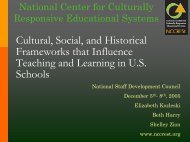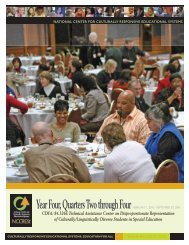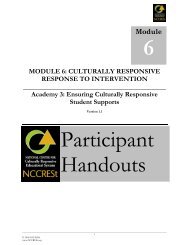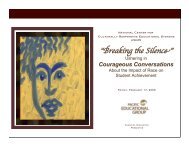Culturally Responsive Pedagogy and Practice - NIUSI Leadscape
Culturally Responsive Pedagogy and Practice - NIUSI Leadscape
Culturally Responsive Pedagogy and Practice - NIUSI Leadscape
Create successful ePaper yourself
Turn your PDF publications into a flip-book with our unique Google optimized e-Paper software.
Roles
Outcomes• Identify Environmental <strong>and</strong> Instructionalelements of culturally responsive classrooms• Define <strong>Culturally</strong> <strong>Responsive</strong> <strong>Pedagogy</strong>• Identify features of culturally responsivepedagogy
AgendaAcademy Overview………………………………………………………..15 minutesOrienting Activity: What Do You Already Do?..................................................15 minutesLecturette 1: Features of <strong>Culturally</strong> <strong>Responsive</strong> <strong>Pedagogy</strong>……………… .50 minutesActivity 1: Self Assessment……………………………...................................15 minutesActivity 2: Characteristics of Teachers….……………………………….....40 minutesLecturette 2: Elements of CR Classrooms…………...…………………….30 minutesActivity 3: Unpacking the Environmental Elements of CR Classrooms…...15 minutesLecturette 3: Features of CR Instruction…………………………………..30 minutesActivity 4: Formative Assessment Strategies………………………………15 minutesActivity 5: Examining Instructional Elements of CR Classrooms………....15 minutesSelf Assessment…………………………………………………………….5 minutesThings to Remember……………………………………………………….5 minutesOutcomes Review……………………………………………….…………10 minutes
Lecturette 1Features of <strong>Culturally</strong> <strong>Responsive</strong> <strong>Pedagogy</strong>(*Review from Academy 1 of this Module)
Dimensions of <strong>Culturally</strong> <strong>Responsive</strong> EducationContentIntegrationPrejudiceReductionEquity<strong>Pedagogy</strong><strong>Culturally</strong><strong>Responsive</strong>EducationKnowledgeConstructionSchoolCulture
Characteristics of <strong>Culturally</strong> <strong>Responsive</strong> <strong>Pedagogy</strong>1. Students receive equal opportunities to achieve fullpotential.2. Student preparation for competent participation i i inincreasingly intercultural society.3. Teacher preparation for effective facilitation of learningfor every student.4. Schools are active participants in ending oppression ofall types.5. Education more fully student-centered <strong>and</strong> inclusive ofthe student voices <strong>and</strong> experiences.6. Educators, activists, <strong>and</strong> others take active role inreexamining i all educational practices <strong>and</strong> dhow theyaffect the learning of all students.
Features of <strong>Culturally</strong> <strong>Responsive</strong> <strong>Pedagogy</strong>gy• Communication of High Expectations• Learning within the Context tof fCulture• <strong>Culturally</strong> Mediated Instruction• Teacher as Facilitator• Student Centered e ed Instruction
Artwork by Vivana-NCCRESt 2006 art contest winnerThe biggest mistake of past centuries in teaching has beento treat all children as if they were variants of the sameindividual id <strong>and</strong> thus to feel justified in teaching them all thesame subjects in the same way.-Howard Gardner
<strong>Culturally</strong> <strong>Responsive</strong> TeachersCultural organizers,mediators, <strong>and</strong>Caring, committed,orchestrators <strong>and</strong> respectful beliefof socialin their students’contextsabilities <strong>and</strong> desireto learnValidate,affirm,facilitate,liberate,<strong>and</strong> empowerExperts ininstruction <strong>and</strong>managementExplicitly teachskills <strong>and</strong> culturalcapitalChallenge<strong>and</strong>supportstudentsHave a sense ofresponsibilityfor all students
Activity 1 – Self Assessment of your<strong>Culturally</strong> ll <strong>Responsive</strong> Classroom• Individually, complete the self assessment form• Discuss your results with a partner or at your table group• Whole group debrief
Activity 2: Characteristics of<strong>Culturally</strong> <strong>Responsive</strong> TeachersPersonal Reflection – complete favorite <strong>and</strong>“not-so-favorite” teacher characteristicsworksheetWhole group share
Classrooms that Meet Human Needs*This slide is for use withActivity 2: Characteristics of<strong>Culturally</strong> <strong>Responsive</strong> TeachersBelongingPowerFunFreedom
Belongingg*This slide is for use withActivity 2: Characteristics of<strong>Culturally</strong> <strong>Responsive</strong> Teachers• Establish a caring environment <strong>and</strong> warm,personal, positive relationships with students• Prevent <strong>and</strong> respond to teasing, bullying <strong>and</strong>exclusion of students• Teach conflict resolution skills to maintainfriendships• Teach social skills <strong>and</strong> use cooperative learningto build a sense of belonging
Power*This slide is for use withActivity 2: Characteristics of<strong>Culturally</strong> <strong>Responsive</strong> Teachers• Create opportunities <strong>and</strong> conditions for academic <strong>and</strong>behavioral success <strong>and</strong> accomplishment for allstudents• Conduct individualized goal setting <strong>and</strong> evaluation• Help students self-evaluateevaluate their performance <strong>and</strong>behavior• Provide frequent positive feedback <strong>and</strong> recognition• Give students numerous responsibilities or jobs withinthe classroom
Freedom*This slide is for use withActivity 2: Characteristics of<strong>Culturally</strong> <strong>Responsive</strong> Teachers• Give students a voice in what they learn <strong>and</strong>how they complete assignments.• Require students to design a plan forimprovement when a problem occurs.• Take students seriously in planning lessons,projects, classroom rules, <strong>and</strong> consequences.• Allow students to have input in creating rules<strong>and</strong> consequences.• Give students free time during the school dayto choose from a variety of learning options.
Fun*This slide is for use withActivity 2: Characteristics of<strong>Culturally</strong> <strong>Responsive</strong> Teachers• Create learning experiences that are fun, creative,relevant, <strong>and</strong> meaningful.• Welcome physical activity.• Allow <strong>and</strong> expecting talking <strong>and</strong> laughter• Give students a wide variety of choices inextracurricular activities.• Include students’ interests in curricular planning.
Activity 2: Characteristics of<strong>Culturally</strong> ll <strong>Responsive</strong> TeachersPart III: Connecting to Basic Human Needs• List actual examples of how your assignedbasic need has been met in a classroom.• After writing some examples, discuss withinthe group: “How did this make you feel?”
Lecturette 2Elements of <strong>Culturally</strong> <strong>Responsive</strong> Classrooms
Reframing the QuestionWhy arestudentsfailing?If we seek to improve studentperformance we must focus on thework or learning experiences weprovide to students (Schlechty,2002).How are thelearningexperiencesprovided by ourdistrict, school,or classroomfailing thesestudents?
Features of CR <strong>Pedagogy</strong> inClassroomsEnvironmentalInstructionalCurricular
Curricular ElementsCurricularCurricularInstructionalmaterials Content delivery Lesson adaptations
EnvironmentalEnvironmental nm nt Elements1. Creating an Environment of Respect <strong>and</strong>Rapport2.Establishing a Culture of Learning3.Families <strong>and</strong> Communities4.Organizing Physical Space <strong>and</strong> Materials5.Encouraging Classroom ManagementSystems
EnvironmentalEnvironmental nm nt Elements1. Creating an Environment of Respect <strong>and</strong>Rapport• Recognition of One’s Own Beliefs <strong>and</strong> Biases• Knowledge of students• Caring relationships• Respect for all• Positive i <strong>and</strong> consistent interactions i amongteachers <strong>and</strong> students
EnvironmentalEnvironmental nm nt Elements2. Establishing a Culture of Learning• Importance of the Content• Student Pride in Work• Expectations for Learning <strong>and</strong> Achievement
EnvironmentalEnvironmental nm nt Elements3. Families <strong>and</strong> Communities• Connect with Families <strong>and</strong> Local Community• Learn about their Funds of Knowledge• Map the Community <strong>and</strong> its Resources (e.g.transportation, industry, museums <strong>and</strong> libraries,recreation centers, <strong>and</strong> other public activities)• Build Communication i Systems that Work
EnvironmentalEnvironmental nm nt Elements4. Organizing Physical Space <strong>and</strong> Materials
Environmental5. Encouraging Classroom Management SystemsMonitor OwnBehaviorManageClassroomProceduresEnsurePositiveStudentBehaviors
EnvironmentalMonitor OwnBehaviorTeaching is first <strong>and</strong> foremost learning, <strong>and</strong> egocentric as it may sound, theteacher’s chief area of study is herself or himself.Only as I discover my own prejudices, face my own fears, give play to my ownstrengths, <strong>and</strong> compensate for my deficits rather than denying them can Ihelp my students do the same.It is both the blessing <strong>and</strong> the curse of teaching that the learning never ends.Every day, I must confront what I am as a teacher <strong>and</strong> what I hope to be.To do less is to be less of a teacher.Author Unknown
EnvironmentalMonitor OwnBehavior• Be aware of the broader social, economic, <strong>and</strong> politicalcontext• Question traditional assumptions of “what works” inclassroom management• Consider when to accommodate students’ culturalbackgrounds <strong>and</strong> when to expect students toaccommodate (Mutual Accommodation)• Examine current practices <strong>and</strong> policies in terms ofequitable treatment
EnvironmentalMonitor OwnBehaviorReflection Questions for Equitable Treatment of Students• Which students are being disciplined most often?• What behaviors are targeted as needing disciplinary attention?• Are we more patient <strong>and</strong> encouraging with some students, while more likely tochastise other students?• What is the root cause of student resistance?• Do we use hairstyle <strong>and</strong> dress to form stereotypical judgments of our students’character <strong>and</strong> academic potential?• Do we use inappropriate, demeaning reprim<strong>and</strong>s toward some students?
EnvironmentalManageClassroomProcedures• Management of Instructional Groups• Management of Transitions• Management of Materials <strong>and</strong> Supplies• Routines for Non-Instructional Activities• Supervision of Educational Assistants
EnvironmentalEnsurePositiveStudentBehaviors• Clear <strong>and</strong> consistent expectations• Monitoring of student behavior is preventative• Clear <strong>and</strong> consistent responses to undesirablebehavior
EnvironmentalActivity 3 – Unpacking theEnvironmental Elements ofCR Classrooms• Describe what your “element” looks like….• Rate how it happens in your room/building•Radar• Rhetoric• Emerging• Accomplishing• What does it look like? How are culturally responsiveclassrooms different from traditional classrooms?• How does instruction <strong>and</strong> assessment need to change inyour setting to become more culturally responsive? Wherewould you start?
Lecturette 3Features of <strong>Culturally</strong> <strong>Responsive</strong>Instruction
Features of CR <strong>Pedagogy</strong>• Communication of HighExpectations• Learning within the context of culture• <strong>Culturally</strong> mediated instruction• Teacher as Facilitator• Student Centered Instruction
Instructional• Grouping strategies• Interactions• Evidence of underst<strong>and</strong>ing• Variety of assessment strategies
InstructionalGrouping strategies• Flexible grouping• Classroom design
InstructionalTeacher-Led GroupsGrouping Options• Whole Class/SmallGroups• IndividualTeacher’sRole• Explains procedures• Provides instructionalscaffold• Facilitates discussion• Provides explicit instruction• Affirms student diversityi• Guides individualdevelopment• Encourages individualid student interests
InstructionalStudent-Led GroupsTeacher’s RoleGrouping Options • Describes students’ roles• Collaborative • Describes students’ interpersonal skills• Performance-Based• Dyad (Pairs)• Encourages student interaction• Monitors group effectiveness• Gid Guides underst<strong>and</strong>ingdi• Affirms student diversity• Identifies students’ needs• Provides instructional scaffold• Provides explicit instruction• Identifies students’ interests or needs• Models instructional strategies• Guides underst<strong>and</strong>ing
InstructionalInteractions• Teacher interactions with class• Teacher interactions with individualstudents• Student to student interactions• Ongoing awareness <strong>and</strong> monitoring ofinteractionsi
InstructionalEvidence of studentunderst<strong>and</strong>ing• Communication i with students• Classroom Assignments
InstructionalVariety of AssessmentStrategies• Initial <strong>and</strong> Ongoing• Formative <strong>and</strong> Summative Assessments• Student self-assessment
InstructionalImproving pov Learningthrough Assessment• Adjustment of teaching• Effective feedback to students• Students actively involved in their own learning• Recognition n of the influence n assessment ssm has onstudents motivation <strong>and</strong> self esteem• Need for students to assess themselves <strong>and</strong>underst<strong>and</strong> how to improve
InstructionalDeterrents to EffectiveAssessment for Learning• Assessing quantity of work versus quality• Greater attention to marking <strong>and</strong> gradingg• Teacher feedback often centered on social <strong>and</strong>managerial purposes versus helping students learn• Teachers not knowing enough about students’learning needs
InstructionalInitial i <strong>and</strong> On-GoingPre-• Assess, Build or Activate background knowledge• Set purpose for lessonDuring• Develop <strong>and</strong> assess student underst<strong>and</strong>ing• Student practicePost-• Provide informative feedback• Determine Next Steps
Activity 4: FormativeInstructionalAssessment Strategies• Split into groups• Assign each group one aspect offormative assessment strategies• Review strategies in the list – select oneto share an example with the wholegroup
InstructionalActivity 5: Examining theInstructional Elements of CRClassrooms• How are culturally responsive classroomsdifferent from traditional classrooms?• How does instruction <strong>and</strong> assessment need tochange in your setting to become moreculturally responsive? Where would you start?
Self AssessmentReview the self audit of a culturallyresponsive classroom that you completed inthe first activity. Jot down some ideas aboutwhat you have learned to improve those areasin which you would benefit from the mostsupport.
Growing as a TeacherTeaching is first <strong>and</strong> foremost learning, <strong>and</strong> egocentric as it may sound,the teacher’s chief area of study is herself or himself.Ol Only as Idiscover my own prejudices, jdi face my own fears, give play to myown strengths, <strong>and</strong> compensate for my deficits rather than denyingthem can I help my students do the same.It is both the blessing <strong>and</strong> the curse of teaching that the learning neverends. Every day, I must confront what I am as a teacher <strong>and</strong> what Ihope to be. To do less is to be less of a teacher.Author Unknown
Things to Remember• Identify Environmental <strong>and</strong> Instructionalti elements of culturally responsive classrooms• Define <strong>Culturally</strong> <strong>Responsive</strong> <strong>Pedagogy</strong>• Identify features of <strong>Culturally</strong> <strong>Responsive</strong> <strong>Pedagogy</strong>
Outcomes ReviewActivity:Outcomes ReviewMaterials: Outcomes Review H<strong>and</strong>outTime Limit: 10 minutesPart 1: Complete your chosen outcome <strong>and</strong> talkwith your small group about what you’velearned. (5 minutes)Part 2: Share your ideas with the whole group. (5minutes)
Outcomes ReviewActivity:Part 1:Outcomes ReviewComplete your chosen outcome <strong>and</strong> talkwith your small group about whatyou’ve learned. Focus on one outcome,or at the most, two outcomes.5 Minutes
Outcomes ReviewActivity:Part 1:Outcomes ReviewComplete your chosen outcome <strong>and</strong> talkwith your small group about whatyou’ve learned. Focus on one outcome,or at the most, two outcomes.4 Minutes
Outcomes ReviewActivity:Part 1:Outcomes ReviewComplete your chosen outcome <strong>and</strong> talkwith your small group about whatyou’ve learned. Focus on one outcome,or at the most, two outcomes.3 Minutes
Outcomes ReviewActivity:Part 1:Outcomes ReviewComplete your chosen outcome <strong>and</strong> talkwith your small group about whatyou’ve learned. Focus on one outcome,or at the most, two outcomes.2 Minutes
Outcomes ReviewActivity:Part 1:Outcomes ReviewComplete your chosen outcome <strong>and</strong> talkwith your small group about whatyou’ve learned. Focus on one outcome,or at the most, two outcomes.1 Minute
Outcomes ReviewActivity:Part 2:Outcomes ReviewShare your ideas with the whole group.
Outcomes ReviewActivity:Part 2:Outcomes ReviewShare your ideas with the whole group.5 Minutes
Outcomes ReviewActivity:Part 2:Outcomes ReviewShare your ideas with the whole group.4 Minutes
Outcomes ReviewActivity:Part 2:Outcomes ReviewShare your ideas with the whole group.3 Minutes
Outcomes ReviewActivity:Part 2:Outcomes ReviewShare your ideas with the whole group.2 Minutes
Outcomes ReviewActivity:Part 2:Outcomes ReviewShare your ideas with the whole group.1 Minute
Thank you!Tell us what you thought…










